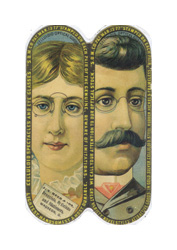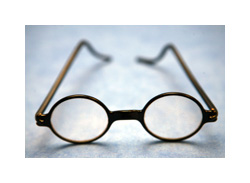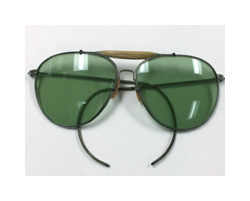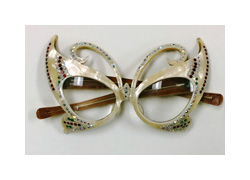1900s
The 1900s saw eyeglasses become an industry of their own, complete with manufacturing and distribution networks. Styles quickly changed in this century as modern celebrities began to influence fashion and new materials became available, especially plastics.Pince Nez

As the 19th century ended, tastes changed toward more inexpensive, everyday spectacles such as the pince-nez. French for “pinch nose,” the pince-nez was first developed in France circa 1840 and began to be imported to America after the 1850s. Their popularity was helped by political figures such as Presidents Teddy Roosevelt and Calvin Coolidge who wore them regularly.
Harold Lloyd

Hollywood actor Harold Lloyd (1893-1971) was known for wearing tortoiseshell spectacles with large, round lenses. His 1920s era movies started a fashion craze for temple spectacles like these.
Sunglasses In the 1930s, sunglasses became popular for the first time. Although colored lenses were available early in spectacle manufacturing, it was not until 1913 that Sir William Crookes of England created a lens capable of absorbing both ultraviolet and infrared light. Further advances in sunglass design were accomplished in order to meet the needs of military pilots in World War II (1939 - 1945). As a result, aviator sunglasses like this example became fashionable.
In the 1930s, sunglasses became popular for the first time. Although colored lenses were available early in spectacle manufacturing, it was not until 1913 that Sir William Crookes of England created a lens capable of absorbing both ultraviolet and infrared light. Further advances in sunglass design were accomplished in order to meet the needs of military pilots in World War II (1939 - 1945). As a result, aviator sunglasses like this example became fashionable.
Plastics
 By the 1940s, advances in the manufacture of plastics made a large variety of frames available in every color of the rainbow. The American Optical Company introduced the first brand name fashion eyeglasses in 1958. From there, designs went in multiple directions from the strictly utilitarian to fantasy models, like this example.
By the 1940s, advances in the manufacture of plastics made a large variety of frames available in every color of the rainbow. The American Optical Company introduced the first brand name fashion eyeglasses in 1958. From there, designs went in multiple directions from the strictly utilitarian to fantasy models, like this example.